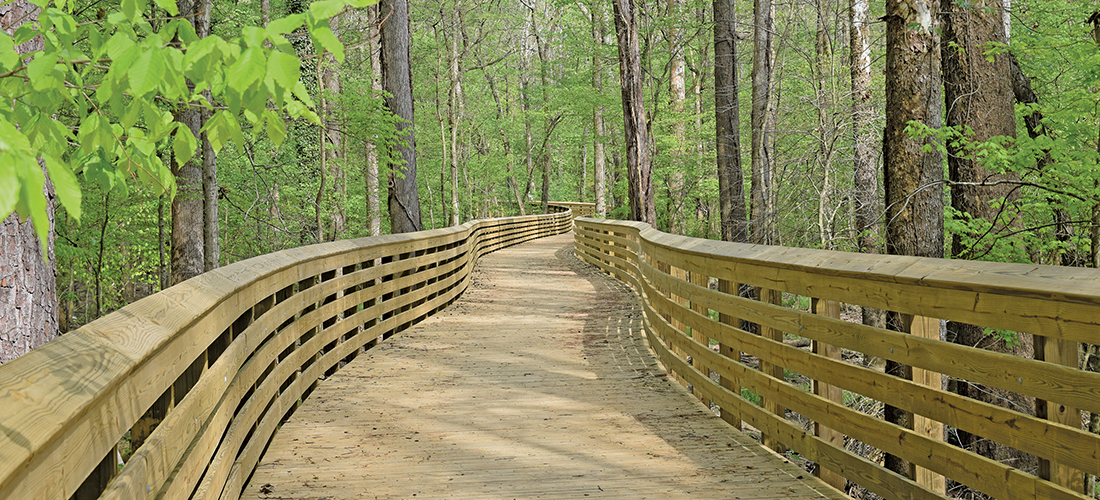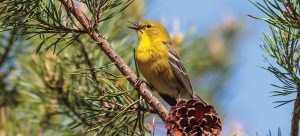
Going with the Flow
Taking the green way to success
By Maria Johnson
Greensboro needed a water feature.
The thought surfaced in the early 2000s, as city promoters and planners explored ways to kick-start the city, especially the anemic center city.
After visits to similar-sized cities, some boosters floated the idea of building a downtown canal or a string of ponds to provide a man-made waterfront that would draw restaurants and entertainment venues, and therefore young people and tourists.
That notion never amounted to more than a ripple — the biggest banks in Greensboro continued to be the kind with drive-through windows — but now, if you squint your eyes and add a splash of imagination, you can see another unifying feature flowing in our midst: the major greenways and their tributaries in Greensboro, High Point and beyond.
Sometimes I think these channels hold a key to lifting the area, both economically and spiritually. The potential gripped me as my husband and I cycled the 4.5-mile High Point Greenway, including a 1.2–mile stretch that opened last summer between Deep River Road and Penny Road, near the Piedmont Environmental Center.
The new section contains a stunning expanse, nearly a half-mile of elevated boardwalk winding through the woods that anchor wetlands around the Deep River, which ironically is neither deep nor wide at that point.
No matter; the boardwalk is the star.
Undulating side-to-side to dodge the biggest trees, the plank road sweeps through a forest that’s enchanted naturally by the thrum of cicadas; the trills of birds; the silhouettes of leaves backlit by the sun; the shafts of light that pierce the canopy and dapple the path.
The boardwalk itself — constructed by subcontractor Backwoods Bridges out of Freeport, Florida — is a wondrous work, with handrails tilted inward and sanded at the joints to be easy on the fingers, and a smooth deck of closely-spaced planks that go easy on the tires and bones.
The day we rode, under a crystal blue sky, a wisp of fall tickled the air. The red maples and dogwoods were just starting to blush at the thought of dropping their green robes. The gorgeous purple blooms of kudzu — hey, even scourges have their good points — perfumed the air. Weaving through the white oaks and red oaks, we spotted sumac and poplar, pawpaw and cottonwood, persimmon and sycamore, ironwood and sweet gum. We couldn’t help but be floored by the diversity of timber.
Yeah, we know a fair bit about trees. We also have plant-identifying apps on our phones.
The natural beauty continued as the new segment ran into older sections of the greenway leading to its end at Armstrong Park, near North Main Street.
Running along a creek called Boulding Branch, the path was lined with downy milkweed, yellow-flowering ironweed and the tiny white starbursts of wild clematis.
There was another kind of beauty at work here, too.
Stay on this — or any other lengthy greenway — for long enough and you’re sure to slice though a cross-section of your community, a vast and varied fabric of people and places.
Unlike trips by plane or train or automobile, enclosures that whiz you past the world at speeds that make absorption difficult, walking or cycling a greenway brings you down to earth, literally.
On the High Point Greenway you witness weary older neighborhoods, once home to legions of furniture factory workers; the red-brick grandeur of High Point University; the deep restful greens of Armstrong Park.
You see young families — some of them looking different from yours, speaking languages different from yours — teaching their children to ride bikes.
You see an ambling professor, coaxing chilly temperatures with a sweater tied over his shoulders.
You see strolling students, weighed down by backpacks and bent toward their phone screens, commiserating.
“Plus, my stupid-idiot-self did this at midday.”
“You’re insane.”
You see young lovers taking pictures of each other on the rocks in the creek.
You see the man, sitting on a tarp in a tunnel, who looks down as you say hello.
You see agile seniors clonking pickleballs at Armstrong Park.
You see the Black Lives Matter fist spray-painted on a utility box.
Walk or ride a greenway, and you’ll see your community in a way you’ve never seen it.
We desperately need those opportunities to connect, not to mention the business opportunities sitting on the “banks” of the greenways.
Right now, maps of the greenways in Guilford County look like a package of gummy worms, with multicolored stretches denoting “completed,” “under construction” and “planned” segments. From the Atlantic & Yadkin Greenway on the north side of Greensboro, to the Downtown Greenway, from the Bicentennial Greenway on the south and west sides of the county, to the High Point Greenway — in theory, all of them will knit together one day.
But assembling the money, land and will to join the threads can be slow going.
The oldest section of the High Point Greenway was dedicated in 1989. The newest leg, the part with the boardwalk, took 10 years — from 2008 to 2018 — to get rolling. The holdup was a property owner who refused to grant an easement, instead offering the whole parcel for $3 million, according to Terry Kuneff, High Point’s interim director of engineering services. Finally, the resistant property owner moved, and the new owner, the Greensboro Chinese Christian Church, gave the green light.
A year later, the city delivered the final leg of the greenway under budget at $3.7 million. Unlike most city projects, Kuneff says, this one brings kudos from citizens.
“People just enjoy it,” he says. “When you walk through the wetland area, you really don’t see anything. It kinda provides you an escape. I don’t know any other way to describe it: It’s just pretty.”
And pretty powerful. OH
Maria Johnson is a contributing editor of O.Henry. She can be reached at
ohenrymaria@gmail.com
Photograph courtesy of High Point Parks and Recreation





